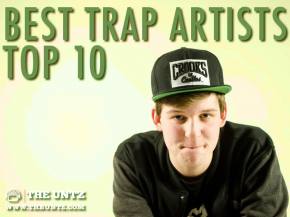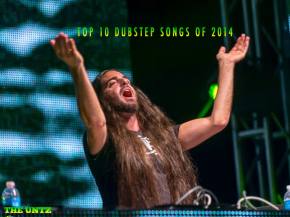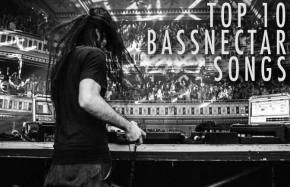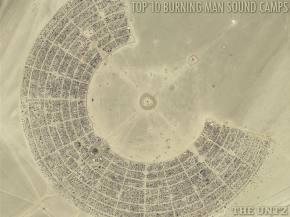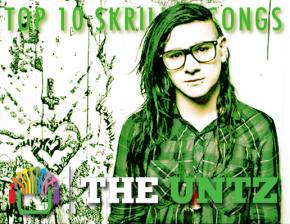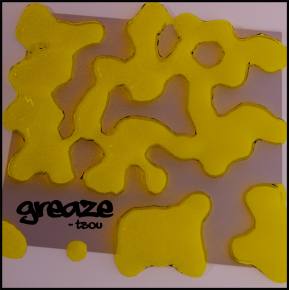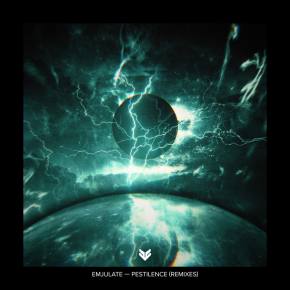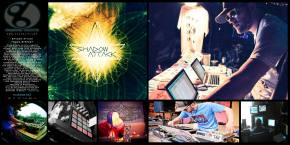Published: October 1, 2012
By: Natty Morrison
If you have read my writings on The Untz, you’re probably familiar with the name Shadow Attack. I have been obsessively listening to everything Jeremy Judkins has released through his own label, Deep Blip Records. His messy beat compositions are reminiscent of Brainfeeder’s bevy of artists, and, since releasing a much heralded live set from Detroit this summer, he’s seen his stock go way up. I sat down with Jeremy to talk about his music, Deepblip, and my own convoluted thoughts on art.
.png)
Natty Morrison: Where did Shadow Attack come from, and what drove you to make the kind of music you’re making?
Jeremy Judkins: I think it was Jaws that Bite. He was there in the beginning, he was always there; we were always making beats together. We made hip-hop beats, electronic, EDM…everything up to drum ‘n bass. We would just perform it as fast and as loud as we could. And it was just him and I for a long time.
NM: Did Jaws that Bite exist before Shadow Attack?
JJ: No, it was simultaneous and separate. But when we played together it was always Shadows that Bite. From that stems Shadow Attack and Jaws that Bite.
NM: Was Shadow Attack your first electronic project? Or were there other incarnations?
JJ: I used to play in a band with Mike Sabatini [Jaws that Bite] in a band called INKFACE. We just jammed, we opened up for like Papadosio; we had a lot of fun. But before that it was just the Auxiliary Jungle, which is a name I still kind of use once in a while, but never too seriously.
NM: When you do use the name, is there a reason?
JJ: It’s a very downtempo set. It’s more of the chill, IDM music when I use it. But I almost never perform under it, I just produce under it occasionally.
NM: What is your least favorite genre of electronic music?
JJ: [Laughs] I don’t know. [Laughs more] Probably psy-trance.
NM: Let me put it another way, what’s your least favorite aspect of the electronic music scene?
JJ: I think it’s the over-concentration of people there for the party. I mean everybody’s going to be taking all kinds of substances at festivals…and I like to have a good time, everybody does. But I’ve seen a lot of people get way too...and even during my sets, it’s hard to see a friend being taken out on a stretcher.
NM: Do you think that’s reflected in the artists too, that they’re willing to play to these drugged out kids and not push themselves to make better music?
JJ: A lot of times it has nothing to do with the music. It could be great, it could be not-so great, but there’s always going to be people just kind of there for the party.
NM: You recently released a much heralded live set from Detroit. Do you feel at home onstage?
JJ: Yes, absolutely. I feel more alive onstage. There’s only a few times a year I’ve been playing lately, and I when I get to get out there and share some of the ideas I’ve been producing, it’s…it’s almost like a rebirth of things, you know? I mean, I don’t really spend a lot of time putting together live sets; I just want it to be live. Everything I’ve been working on the past six months is going into this set tomorrow.
NM: How do you differentiate between a DJ and an artist, and are those the two terms that you would use?
JJ: I think it’s very easy to be able to mix two tracks together, depending on which medium you’re using, whether it be computer or CDJ’s or vinyl, but the artistry that goes into it differentiates between a DJ and someone who’s actually able to produce and mix music well. A lot of producers, especially the ones that are on Deepblip, are incredible DJs and incredible producers, so they’re always going to be putting out quality music. And a lot of times, especially in our area, it’s a lot of the same music that the DJs are throwing down. Being a producer is having a lot friends around us that play our music out live. I get really excited when I see that. It’s everybody sharing everybody’s music.
NM: I like that idea. To me, a DJ is someone who plays the right track at the right time, whereas an artist is someone who makes something original on their own.
JJ: Well, yeah, but even if it’s someone’s music, they’re making it their own.
NM: Right, it’s essentially re-appropriation.
JJ: Yeah.
NM: This is a weird question, and I’m lifting this from Chuck Klosterman, but for you, at what point does something become art? When does it stop being you making something and become art?
JJ: Whenever I’m working on something I can get to a point where I’m happy to it, and I think it’s a good start, but there’s always that one point in the process in any piece of music where everything is in its right place. That a-ha moment.
NM: The song is done when you release it, which is that cathartic moment of it being done. So for you, is art a finished project?
JJ: It doesn’t have to be, as long as it’s always being worked on. There are a lot of working ideas that Sab and I end up performing live that have always been ideas; they never became a finished project. I’d like to think that each release of being a piece of a timeline, but at the same time, each one of those pieces is split into twelve tracks that of music that can always be worked on.
NM: Is there an element of improvisation in your live sets?
JJ: Definitely. There’s some things I have worked out in the way of controller cues, but actually manipulating samples is improved. And the knobs; I like those the most.
NM: Imagine if you could control the reactions of your audience at a show. Would you want them to dance?
JJ: I think the greatest misconception you can have is that music, in its primal state live, has to be danced to in order to be appreciate it.
NM: So if people aren’t dancing, you don’t feel uncomfortable?
JJ: Oh, no. Not at all. Especially when it’s being listened to. I’d rather have somebody in the crowd who is really listening as opposed to just hearing. But sometimes listening can cause a physical reaction, like dancing, and a lot of times I’ll play stuff that’s dancier anyway.
NM: So you feel like you sometimes tailor your set to fit the crowd?
JJ: Well, when I’m playing live, I like to have a good time, and I want other people to have a good time. So I can sort of make it up-tempo, and a lot of the stuff I produce is a little slower, and beatier and spacey, and I want to push that, but in live setting I want it to be more up-tempo. Maybe a little more dancey, but I don’t think I ever feel uncomfortable.
NM: You said you feel more alive onstage, but, artistically, do you feel more fulfilled working in the studio? Especially since you don’t have to think about anyone but yourself?
JJ: Yeah, the culmination of ideas into a finished product is the ultimate high. And being able to put those in front of a few hundred people is always an insane joy, especially this weekend, at this show, I’m going to be putting about 6 or 7 of those ideas to work.
NM: You’re not nervous?
JJ: No. [Laughs] Well, I don’t know if it’s going to go well, but I’m not nervous.
If you have read my writings on The Untz, you’re probably familiar with the name Shadow Attack. I have been obsessively listening to everything Jeremy Judkins has released through his own label, Deep Blip Records. His messy beat compositions are reminiscent of Brainfeeder’s bevy of artists, and, since releasing a much heralded live set from Detroit this summer, he’s seen his stock go way up. I sat down with Jeremy to talk about his music, Deepblip, and my own convoluted thoughts on art.
.png)
Natty Morrison: Where did Shadow Attack come from, and what drove you to make the kind of music you’re making?
Jeremy Judkins: I think it was Jaws that Bite. He was there in the beginning, he was always there; we were always making beats together. We made hip-hop beats, electronic, EDM…everything up to drum ‘n bass. We would just perform it as fast and as loud as we could. And it was just him and I for a long time.
NM: Did Jaws that Bite exist before Shadow Attack?
JJ: No, it was simultaneous and separate. But when we played together it was always Shadows that Bite. From that stems Shadow Attack and Jaws that Bite.
NM: Was Shadow Attack your first electronic project? Or were there other incarnations?
JJ: I used to play in a band with Mike Sabatini [Jaws that Bite] in a band called INKFACE. We just jammed, we opened up for like Papadosio; we had a lot of fun. But before that it was just the Auxiliary Jungle, which is a name I still kind of use once in a while, but never too seriously.
NM: When you do use the name, is there a reason?
JJ: It’s a very downtempo set. It’s more of the chill, IDM music when I use it. But I almost never perform under it, I just produce under it occasionally.
NM: What is your least favorite genre of electronic music?
JJ: [Laughs] I don’t know. [Laughs more] Probably psy-trance.
NM: Let me put it another way, what’s your least favorite aspect of the electronic music scene?
JJ: I think it’s the over-concentration of people there for the party. I mean everybody’s going to be taking all kinds of substances at festivals…and I like to have a good time, everybody does. But I’ve seen a lot of people get way too...and even during my sets, it’s hard to see a friend being taken out on a stretcher.
NM: Do you think that’s reflected in the artists too, that they’re willing to play to these drugged out kids and not push themselves to make better music?
JJ: A lot of times it has nothing to do with the music. It could be great, it could be not-so great, but there’s always going to be people just kind of there for the party.
NM: You recently released a much heralded live set from Detroit. Do you feel at home onstage?
JJ: Yes, absolutely. I feel more alive onstage. There’s only a few times a year I’ve been playing lately, and I when I get to get out there and share some of the ideas I’ve been producing, it’s…it’s almost like a rebirth of things, you know? I mean, I don’t really spend a lot of time putting together live sets; I just want it to be live. Everything I’ve been working on the past six months is going into this set tomorrow.
NM: How do you differentiate between a DJ and an artist, and are those the two terms that you would use?
JJ: I think it’s very easy to be able to mix two tracks together, depending on which medium you’re using, whether it be computer or CDJ’s or vinyl, but the artistry that goes into it differentiates between a DJ and someone who’s actually able to produce and mix music well. A lot of producers, especially the ones that are on Deepblip, are incredible DJs and incredible producers, so they’re always going to be putting out quality music. And a lot of times, especially in our area, it’s a lot of the same music that the DJs are throwing down. Being a producer is having a lot friends around us that play our music out live. I get really excited when I see that. It’s everybody sharing everybody’s music.
NM: I like that idea. To me, a DJ is someone who plays the right track at the right time, whereas an artist is someone who makes something original on their own.
JJ: Well, yeah, but even if it’s someone’s music, they’re making it their own.
NM: Right, it’s essentially re-appropriation.
JJ: Yeah.
NM: This is a weird question, and I’m lifting this from Chuck Klosterman, but for you, at what point does something become art? When does it stop being you making something and become art?
JJ: Whenever I’m working on something I can get to a point where I’m happy to it, and I think it’s a good start, but there’s always that one point in the process in any piece of music where everything is in its right place. That a-ha moment.
NM: The song is done when you release it, which is that cathartic moment of it being done. So for you, is art a finished project?
JJ: It doesn’t have to be, as long as it’s always being worked on. There are a lot of working ideas that Sab and I end up performing live that have always been ideas; they never became a finished project. I’d like to think that each release of being a piece of a timeline, but at the same time, each one of those pieces is split into twelve tracks that of music that can always be worked on.
NM: Is there an element of improvisation in your live sets?
JJ: Definitely. There’s some things I have worked out in the way of controller cues, but actually manipulating samples is improved. And the knobs; I like those the most.
NM: Imagine if you could control the reactions of your audience at a show. Would you want them to dance?
JJ: I think the greatest misconception you can have is that music, in its primal state live, has to be danced to in order to be appreciate it.
NM: So if people aren’t dancing, you don’t feel uncomfortable?
JJ: Oh, no. Not at all. Especially when it’s being listened to. I’d rather have somebody in the crowd who is really listening as opposed to just hearing. But sometimes listening can cause a physical reaction, like dancing, and a lot of times I’ll play stuff that’s dancier anyway.
NM: So you feel like you sometimes tailor your set to fit the crowd?
JJ: Well, when I’m playing live, I like to have a good time, and I want other people to have a good time. So I can sort of make it up-tempo, and a lot of the stuff I produce is a little slower, and beatier and spacey, and I want to push that, but in live setting I want it to be more up-tempo. Maybe a little more dancey, but I don’t think I ever feel uncomfortable.
NM: You said you feel more alive onstage, but, artistically, do you feel more fulfilled working in the studio? Especially since you don’t have to think about anyone but yourself?
JJ: Yeah, the culmination of ideas into a finished product is the ultimate high. And being able to put those in front of a few hundred people is always an insane joy, especially this weekend, at this show, I’m going to be putting about 6 or 7 of those ideas to work.
NM: You’re not nervous?
JJ: No. [Laughs] Well, I don’t know if it’s going to go well, but I’m not nervous.


